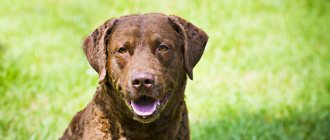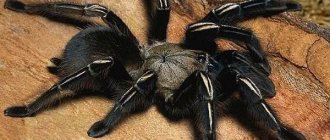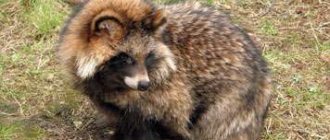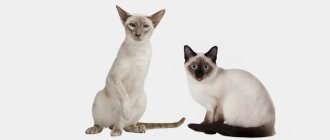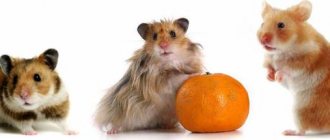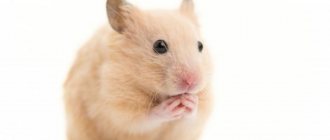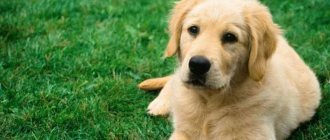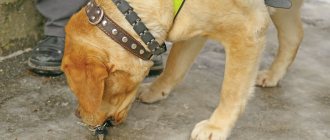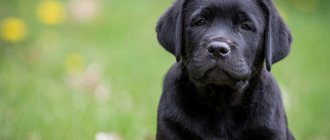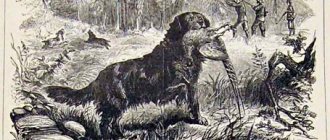Differences in origin
The Golden Retriever (in ordinary life it can be simply called a Golden) was created thanks to the intervention of a person who purposefully crossed different breeds in order to create a dog that would become an ideal assistant during the hunt.
Typical representatives of breeds
The fawn Flat-Coated Retriever was originally bred by crossing a Newfoundland and a Setter. His subsequent crossbreeding with the Tweed Water Spaniel (an English dog bred on the banks of the Tweed River) marked the birth of the Golden Retriever.
The breed continued to be improved through repeated crossings with fawn Blandhounds and Tweed Water Spaniels. As a result, retrievers became the owners of a more subtle sense of smell and a powerful body. The resulting breed absolutely suited the English hunter lords. Golden retrievers gained international recognition at the beginning of the 20th century.
Additional Information. The legend of Lord Twinmouth, who claimed that the long-haired retriever was descended from sheepdogs, is absolutely implausible. Currently, there are several types of retrievers; they were mainly bred from pointers and spaniels.
Labradors
These are descendants of dogs that lived in Indian fishing villages on the island of Newfoundland, Canada. Dogs pulled fishing nets ashore and pulled sleds in winter. Newfoundlands were brought to England in the 19th century. The wonderful Labrador was created by crossing a Newfoundland with a curly-haired retriever, a foxhound and, possibly, a setter.
Important! Representatives of these breeds have common roots, which explains their some similarities in appearance and behavior.
Differences in breed standard
The differences between retrievers and Labradors are reflected in the standards for both breeds. Outwardly they are similar, but each of them has special features. Their characters also differ. You can make a thorough comparison and find the main differences between Labradors and Retrievers.
Frame
Retrievers have a graceful physique and magnificent grace. The long neck blends smoothly into the back. Labradors are sturdier and more muscular, with strong bones, a wide chest and a short neck. Because of these features, the Labrador seems heavy, and the retriever seems light and sophisticated.
The Golden's muzzle is slightly elongated. Their ears are longer than those of a Labrador, and they are set lower. Goldens have dark brown eyes with pigmentation on the eyelids, which makes their gaze very expressive. The eyes of Labradors can have different colors: brown, hazel, chocolate, etc. Eyeliner is rare.
The retriever's strong paws are well proportioned and are ideal for running quickly and for long periods of time. Labradors were bred to be working dogs, not hunting dogs, so it is not so important for them to run lightly and quickly. The height and weight of both breeds are approximately the same.
Note! Working dogs weigh less than show animals.
Retrievers can be colored in any shade of golden.
Coat and color
Retrievers have a thick and dense undercoat. Their long coat can be straight or wavy. Waves can be seen on the neck, chest, legs and tail. The fur on the fringes is slightly lighter than on the rest of the body.
Labradors have short (up to 5 cm), smooth and straight hair. There should be no waves or small frays. The Hairy Labrador is a rarity that does not meet the standards. Thick hairs have a waxy shine, which is given to them by natural fatty lubricant. The dense undercoat does not allow water to pass through and protects the animal from getting wet.
In order not to confuse these two breeds, you need to pay attention to the wool. If a Labrador is long-haired, then it is a retriever, since all Labradors are short-haired.
Golden Retrievers come only in golden color. Their soft fur can have any shade: light fawn, cream, beige, opal, etc. There are also rarer species - mahogany and bright red. Labradors can have several color options:
- black;
- pale yellow;
- chocolate and other shades of brown.
Having heard about the Golden Labrador breed, you need to take a closer look at the pet. If it has long, wavy fur, it is a retriever. If the coat is short and straight, and the dog itself is large and muscular, it is a Labrador with a beautiful and rare shade of fawn coat. Most often it turns out that the golden Labrador is a cross between these two breeds.
Note! Labradors shed almost all year round, while retrievers shed only twice a year. During this period, the pet must be combed.
Retrievers have a graceful body and a bushy, feather-like tail.
Tail
The shape and position of the tail can easily distinguish one dog from another. In Labradors, the transition from back to tail is smooth and almost imperceptible. At the transition point, the tail is thick at its base, but tapers towards the tip. This shape is called an “otter tail”; it never bends towards the back. He has short fur. When a dog is having fun, its tail may lift up and move quickly.
In retrievers, the spine passes from the back to the tail at a slight angle. The tail never rises high and continues the line of the back. It is covered with thick long hair (dewlap) and looks like a feather. Setters have the same traits.
Labradors have a strong build and a strong tail with a narrow tip.
Visible differences between representatives of breeds
Akita Inu and Shiba Inu: differences, what is the difference
Retriever and Labrador are dogs of approximately equal dimensions: height at withers 55-57 cm, weight 25-40 kg. However, a careful study of external data will allow you to clearly understand how the Golden Retriever differs from the Labrador.
Body type
The Labrador has a powerful body and strong legs. The head is massive. The tail is thick at the base, covered with short hair, and at a moment of joy it becomes at an angle of 90 degrees to the back.
The retriever is also a large, muscular dog, but looks more graceful. The head is large, but not massive. The tail is decorated with a fluffy dewlap of lighter hair, always positioned straight, and only slightly raised in moments of joy.
Golden Retriever in all its glory
Wool
Labradors have a thick, silky coat. The guard hair is dense, hard and straight, up to 5 cm long. No waviness or curling is observed. Their wool repels water well, as it is impregnated with a special composition resembling wax. After touching the dog, this composition leaves a mark on the hands, which is not always pleasant. When choosing a pet, you should take this nuance into account.
The retriever is endowed with wavy coat of golden shades. Outwardly, he is hairier than a Labrador. The back of the paws, hips, neck and tail of the golden are covered with long, lighter-colored hair.
Color
When breeding retrievers, they sought to obtain a color that would stand out noticeably against the background of marshy areas. Individuals with bright colors were chosen, so the dogs have a full range of golden shades (from fawn to bright red). Different shades of these colors are possible: golden, light cream, red fox, liver.
The standard color of a Labrador is chocolate, fawn or black.
Three comrades: black, white and chocolate
Note! It is much easier to confuse a retriever and a Labrador if the dogs have a golden color, which both breeds can have. In other cases, it is much easier to distinguish representatives of these breeds.
Visible differences
Color. When Lord Tweedmouth bred his breed, he preferred a color that was clearly visible against the background of dark peat bogs. For Golden Retrievers, the entire range of golden shades is acceptable.
Golden Retrievers: from light gold to dark gold
If the dog is black or chocolate, it is a Labrador. Ambiguity can arise only in one case: both Golden and Labrador have a color close to fawn.
Chocolate, fawn, black - the classic “trio”
Wool is one of the distinguishing features of the Labrador. It has a characteristic property of waterfowl dogs - it is covered with a specific coating that is easily tangible. Those who choose a pet should pay attention to this feature - not everyone likes the “greasy” (rather, waxy) coating. The guard hair is dense, thick and elastic, not silky. The length of the spine is no more than 5 cm. Wave and curl are unacceptable.
The Golden Retriever has a more decorative coat - shiny golden shades, often with a slight wave. On the back of the paws, hips, neck and tail there are beautiful long feathers, often lighter than the main tone.
Golden: impeccable appearance, noble character
The Labrador can be distinguished by its “otter” tail - thick at the base, covered with short, strong hair. The Golden Retriever has a tail feather adorned with a dewlap, like that of a setter. A Labrador, when in high spirits, carries its tail “cheerfully” - almost at a right angle to the back, while in a retriever the line of the tail continues the line of the back, only sometimes rising slightly upward.
Labrador: nothing extra
The Labrador's head looks somewhat more massive: the breed was used for hunting relatively large prey, including a hare (the weight of an adult hare is 4-6 kg), while the Golden Retriever is “sharpened” for lighter game birds.
Purpose of dogs
Pitbull and Stafford: differences between terriers, what is the difference
For several centuries, representatives of the breeds faithfully served man. And today, thanks to their endurance, calmness and intelligence, they provide invaluable assistance in many areas of life.
Retrievers
Initially, they were bred for hunting - they had to get game shot by the hunter from swamps, reservoirs, and thickets. The dog was required to follow its owner quietly, without making unnecessary sounds, until the moment of the shot. Preference was given to calm individuals who did not strive to compete with the cops, but were able to quickly find and, without tearing them to pieces, bring killed prey or a wounded animal to the feet of the hunter. Such abilities were cultivated as the ability to wait, not rush forward, and remain calm and quiet. The retriever is a good swimmer.
Golden retriever on the hunt
The animal’s ability to carefully use its powerful jaws (the so-called “soft tooth”) was especially valued. This quality is the main distinguishing characteristic, manifested by a complete absence of aggression. Therefore, goldens are very friendly and have a positive attitude towards people, including strangers. They are not suitable for protection.
Labradors
From Portuguese the word labrador is translated as worker, worker. Previously, they were used as traction force - to move heavy loads. These dogs are very strong, they are suitable for hunting larger prey (the weight of a hare reaches 4-6 kg).
Dogs, after undergoing a set of special training, become wonderful guides and nannies for people with poor eyesight and the completely blind. In recent decades, dogs have been actively used in this direction. They are taught not only to accurately execute a command, but also to analyze the current situation. For example, she is given the command “to the right,” but there is an obstacle in the way (a car is parked). In this case, the guide must find a way around himself.
Important! A keen sense of smell allows Labradors to be successfully used in search and rescue operations.
Attitude towards children and pets
Malamute and husky: differences, what is the difference, who to choose
What makes dogs similar are qualities such as positivity and friendliness towards everything around them. They interact peacefully with people, even strangers, and love to play with children. They know how to make friends with other dogs, cats and other pets. Their presence has a beneficial effect on the emotional situation in the house.
Tender relationships
The Golden Labrador and Golden Retriever love nature and exercise, but are able to adapt to any environment. Pets need to “release” accumulated energy. If they live in an apartment, then during a walk they need to be given the opportunity to run around as much as possible. They will return home tired but happy.
What are the differences?
There are several major differences between Labradors and Golden Retrievers related to their appearance and personality.
Coat type and what they look like in the photo
The coat of Labradors is covered with a specific waxy coating, characteristic of frequently swimming dogs. The guard coat is thick, elastic and dense, without curling or waviness.
Golden retrievers have a more decorative coat: it is shiny and slightly wavy . Beautiful feathering is clearly visible on the tail, neck, hips, and back of the forelimbs.
Body type
Labradors have a dense, muscular body and strong bones . They have a wide chest and back and a short loin, ears are slightly shorter and set higher, the head is larger, and the muzzle is less elongated.
The physique of goldens is more graceful. They have a longer neck, and some standards provide an angled transition to the tail.
The limbs of representatives of this breed are more proportional and better adapted to fast running..
Temperament and training
Both breeds are friendly, cheerful and lack aggression, but Labradors require a more active lifestyle and more exercise.
Both Labradors and Golden Retrievers respond well to training..
Minor problems may arise during training with Labradors - due to increased playfulness, representatives of this breed can be distracted, so you will need to show patience and restraint.
Who is smarter and more trainable?
Training requires patience and skill. If you have no experience, it is better to seek help from a professional dog handler. In a couple of months he will turn the dog into a docile, socially adapted animal. Training begins at 6-7 months, but there are courses for smaller puppies. Purebred puppies with good pedigree learn quickly.
Goldens are calm and attentive; their natural slowness is manifested in the fact that they first think about a command and only then carry it out.
For your information! A well-trained pet is able to perform more than 50 commands (turn off the lights, bring slippers).
When training Labradors, you need to take into account their violent temperament. You will have to be patient and direct the puppy’s irrepressible energy in the right direction. Gently and patiently, repeat the command several times (as many times as necessary) and achieve its execution. Properly raised dogs have self-esteem. Everyone gets great pleasure from communicating with them.
It is difficult to definitively answer the question of who is smarter – a Labrador or a retriever. The breeds are among the ten smartest dogs. Much depends on the individual characteristics of a particular individual, its hereditary data and on the owners themselves. They adopt the behavior of the person who deals with them, and in a nervous environment they become uncontrollable and aggressive.
Daily workout
External differences
Both breeds are similar in that they have a massive head, light coloring and floppy ears. At first glance they seem similar, but upon closer examination the differences will be visible. The Retriever has a long, straight coat and a fluffy appearance. Labradors are shorter-haired and have a shiny coat. They have a thick undercoat that protects them from moisture and cold.
Characteristics of a retriever:
- All shades of cream and gold are allowed in color;
- the tail is heavy and pendulous;
- The retriever does not curl its tail over its back.
Labradors are more variable in color. Black, brown, chocolate, fawn shades are allowed. There are white dogs, but this is considered a defect, and such individuals are excluded from breeding. The Labrador's tail is thin at the end and thick at the base. The dog can lift it, but without bending it towards the back.
Both breeds have almost no differences in weight and height - the average weight is 62 kg, height at the withers is 62 cm.
Who is more picky about feeding?
It is assumed that a healthy dog that is hungry after exercise should not be picky about food. It is not always so. Pampered, overfed pets prefer to starve than to eat something they don’t like.
Retrievers are more prone to this behavior. It’s not for nothing that they were called “aristocrats.” To avoid such problems, feeding by the hour (no more than 2 times a day for adults), no snacks between main meals, and regular physical activity will help.
Labradors have a tendency to allergies, which forces them to plan their menu more carefully.
Who is better to choose
The popularity of retrievers, which has reached its peak in recent decades, is explained by their characteristics:
- flexibility and friendliness;
- ability to train in a variety of ways;
- aristocracy and nobility of appearance.
The long-haired Labrador is in no way inferior to the retriever. This is a different breed of dog, with its own pros and cons. He is unpretentious and hardy. He has a simple, cheerful disposition.
Important! Every dog needs a physically and psychologically strong companion who can win its respect and love and control its behavior.
The choice must be made not on the basis of momentary desire, but taking into account your housing, physical and material capabilities. A dog is a living being; it is necessary to provide it with decent living conditions in which it can develop harmoniously.
Mother of many children
How much do they cost and where to buy
The market is not the place to buy Labrador and Retriever puppies. You can choose a healthy pet from quality producers only in specialized canine nurseries and professional breeders. Information about them can be found on the Internet on sites specializing in these issues, and from the organizers of dog shows.
The Retriever Club is considered one of the best golden dog kennels in Russia. Its breeders guarantee the purity of the breed and warn about the presence of abnormalities in the puppy, if any. Individuals for mating are selected strictly according to certain criteria. A puppy that meets all the requirements receives a pedigree, which ensures its participation in various competitions.
For your information! The cost of puppies from purebreds with good pedigree parents ranges around 400 USD. e.
Despite the differences between these breeds, both dogs require sufficient living space and daily exercise. Future owners must foresee and take into account all the factors and understand exactly what a retriever and a Labrador are, what is the difference between these wonderful dogs.
